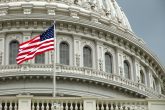February 12, 2020
The Dangers of Manipulated Media in the Midst of a Crisis
In the immediate aftermath of the U.S. drone strike that killed Iranian General Qasem Soleimani, the internet was flooded with purportedly real-time information about the circumstances surrounding the attack and possible Iranian retaliation. The event played out on social media as one would expect. On Twitter, thousands of users claimed access to facts on the ground. In one instance, a Twitter user tweeted out a photo, alleging that an Iranian missile struck Iraq’s Ain al-Asad air base. The tweet spread rapidly. Eventually, reputable news sources stepped in and debunked the story—revealing that the tweeted image was from an entirely separate incident months earlier.
It is in these moments of crisis and uncertainty that disinformation can gain a remarkable foothold and a piece of manipulated media could spark mass panic. The escalating tension between the United States and Iran, showcased in real time on social media, is a stark reminder that manipulated media—photos, video, or audio that have been edited, distorted, or misappropriated—have the capacity to incite violence, disrupt elections, and harm diplomatic relations.
Lawmakers, social media companies, research labs, and technology experts are working to address the proliferation of manipulated media, but these efforts have so far been insufficient. For real progress to be made, social media companies must play a greater role in limiting the harmful effects of manipulated media. Also, policymakers, tech companies, and researchers need to cooperate to ensure that today’s digital environment is safeguarded against malicious actors looking to sow disinformation, while also protecting the rights of Americans online.
Read the full article from the Council on Foreign Relations' Net Politics blog.
More from CNAS
-
Securing U.S. Democracy Initiative
America Must Promote Democracy, Despite Trump’s Disdain for ItA dysfunctional U.S. democracy at home makes it less credible to support liberalism abroad....
By Richard Fontaine
-
Securing U.S. Democracy Initiative
Sharper: The Next CongressWhen the 117th Congress is sworn in next January, legislators have the opportunity to exert substantial influence on the future of America's role in the world....
By Katie Galgano, Chris Estep & Cole Stevens
-
Securing U.S. Democracy Initiative
The Death and Rebirth of American InternationalismThe time has come for Americans to rethink their country’s role in the world and fashion an internationalism suited to today’s realities....
By Edward Fishman
-
Securing U.S. Democracy Initiative
Republicans Can Learn From Democrats’ Foreign Affairs Committee ContestRepublican legislators in both the House and the Senate have ample time to draw lessons from Engel’s loss and translate them into reform....
By Chris Estep




